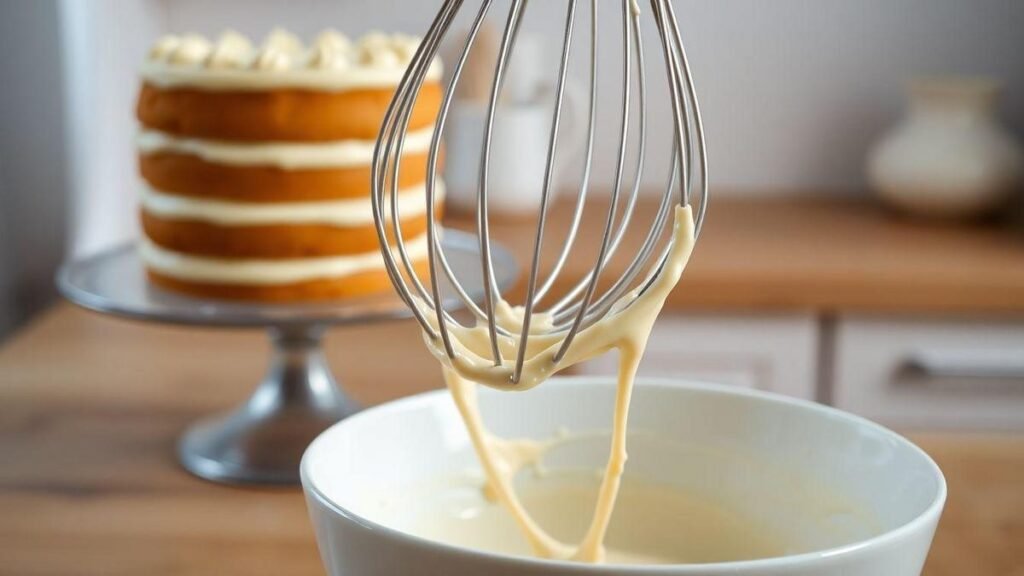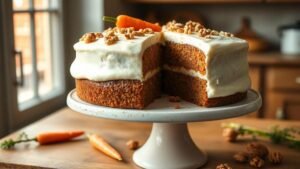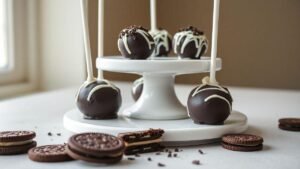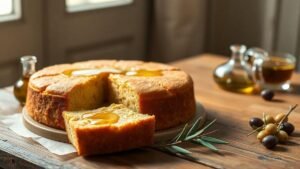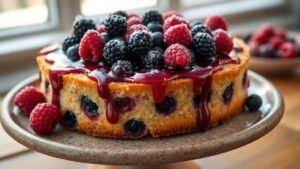How to Make a Moist Vanilla Layer Cake Without a Mixer
I used to think a stand mixer was the only way to get a showy layer cake — then I learned to whisk my way to glory. This guide shows you how to make a moist vanilla layer cake with no electric equipment, using a whisk, a bowl, a serrated knife to level, and an offset spatula or the back of a butter knife to frost. If you enjoy low-tech baking, see this guide on making a layer cake without a mixer for similar no‑mixer strategies. I share simple hand‑mixing tips, the crumb coat trick, how to frost and decorate with berries or chocolate shavings, easy frostings, flavor variations, and storage advice. You don’t need fancy tools—just patience, good ingredients, and a little cheeky confidence.
Key takeaways:
- Bake a fluffy layer cake without any electric tools.
- Use simple tools like a whisk, bowl, serrated knife, and spatula or butter knife.
- Level layers, add a thin crumb coat and chill, then frost and decorate simply.
- Make easy frostings by hand and try flavor variations.
- Store the cake properly to keep it moist.
Why Make a Layer Cake by Hand?
I make cakes by hand because it feels honest, quiet, and cheap — and it’s a great party trick. People treat mixers like magic; I like to burst that bubble with a whisk.
Quick reasons:
- No gear: you need only a whisk and a bowl (and if you want to try even fewer tools, there’s a method for making a cake using only a fork and a bowl at using only a fork and a bowl).
- Simple: less cleanup, fewer wires.
- Pride: bigger bragging rights.
- Good texture: hand mixing can make a light crumb if you do it right.
Tools You’ll Need
If my kitchen tools had a dating profile, these would be the ones I swipe right on:
- Large bowl — mix batter and fold ingredients.
- Whisk — beat eggs and sugar, fold dry parts.
- Rubber spatula — scrape the bowl clean.
- Serrated knife — level cakes.
- Offset spatula or the back of a butter knife — spread frosting.
- Two 8- or 9-inch cake pans — for even layers (or learn creative workarounds if you don’t have pans in how to make a cake without a cake pan).
- Parchment paper — prevents sticking.
- Cooling rack — cool cakes quickly.
Important words: whisk, spatula, level.
Moist Vanilla Layer Cake (No Mixer Needed)
This simple, forgiving recipe bakes like a charm.
Ingredients
Dry:
- 2 1/2 cups all-purpose flour
- 2 1/2 tsp baking powder
- 1/2 tsp salt
- 1 cup granulated sugar
- 1/2 cup sour cream or plain yogurt
Wet:
- 1 cup whole milk
- 1/2 cup vegetable oil
- 2 large eggs, room temperature
- 2 tsp vanilla extract
Important: room temperature eggs make the batter smoother and help trap air.
If you like yogurt-based cakes, see tips for achieving extra tenderness in this piece on making a soft cake with yogurt.
Instructions
- Preheat oven to 350°F / 175°C. Grease pans and line with parchment.
- Whisk dry ingredients together in a bowl.
- In a second bowl, whisk eggs and sugar until pale and slightly frothy (about 2–3 minutes by hand).
- Stir in oil, vanilla, and sour cream until smooth.
- Add dry and milk in 3 turns, alternating: dry → milk → dry. Fold gently with a rubber spatula until just combined.
- Divide batter between pans. Tap pans on the counter to level.
- Bake 22–28 minutes, until a toothpick comes out clean.
- Cool 10 minutes in pans, then turn onto a rack. Trim tops if needed.
Tip: When I say fold, I mean slow and kind—don’t beat the air out. For more on how beating eggs contributes to lift (and how that differs between cake types), read a simple comparison of sponge cake and butter cake.
Tips for Mixing Batter by Hand
Common problems and fixes:
- Lumpy batter — sift flour or whisk dry mix first.
- Over-mixed batter — fold gently and stop when streaks vanish.
- Dense cake — beat eggs and sugar until pale; that adds lift.
- Sticky spatula — use a bowl scraper or wet your spatula slightly.
If something goes wrong, the site has a helpful roundup of common cake baking blunders and how to fix ’em, and specific advice for rescuing a dried‑out cake in what to do when your cake is too dry.
A quick confession: I once beat eggs with a fork because my whisk vanished. The cake was fine. Keep the whisk visible.
How to Layer and Frost Without Special Tools
You don’t need a turntable. I use a dinner plate and steady hands.
Steps:
- Level the cakes: Use a serrated knife and small sawing strokes. Chilling cakes 10 minutes helps them slice cleaner.
- Crumb coat: Spread a thin layer of frosting to trap crumbs. Chill 10–15 minutes.
- Final frost: Use an offset spatula or the back of a butter knife. Smooth with long strokes and wipe the blade between passes.
- Decorate: Add berries, chocolate shavings, edible flowers, or a dusting of powdered sugar — or follow low‑tool decorating ideas in simple ways to decorate without piping bags. For fruit accents and tips on placement, see using fruit as a natural cake topping. If you prefer glossy finishes, a chocolate ganache or a simple glaze can be poured over chilled cakes.
A little chill time makes the cake behave — that’s the secret handshake.
Easy Frostings to Make by Hand
Keep frosting simple and tasty — nothing too fussy.
Simple buttercream:
- 1/2 cup butter, softened
- 2 cups powdered sugar
- 1–2 tbsp milk
- 1 tsp vanilla
Method: Whisk butter until soft, add powdered sugar slowly, add milk to thin.
Cream cheese frosting:
- 1/2 cup cream cheese, softened
- 1/4 cup butter, softened
- 1 cup powdered sugar
- 1 tsp vanilla
Method: Whisk softened dairy together, add sugar and mix until smooth.
Whipped cream:
- 1 cup cold heavy cream
- 2 tbsp powdered sugar
- 1 tsp vanilla
Method: Whisk cold cream until soft peaks form; sweeten to taste. Tip: chill the mixing bowl for faster whipping.
For a rich, glossy finish or a contrast to vanilla, try a quick chocolate ganache, or crown simple cakes with a versatile glaze.
Flavor Variations
Playful swaps:
- Vanilla: add lemon zest or 1 tsp almond extract.
- Chocolate: replace 1/3 cup flour with 1/3 cup cocoa powder.
- Spice: add 1 tsp cinnamon and 1/2 tsp nutmeg.
- Citrus: replace half the milk with orange or lemon juice for a bright note.
I once made an espresso cake and left it on the porch — neighbors applauded at dusk. True story.
If you want even simpler one‑bowl variations for busy days, check out these easy one‑bowl cake recipes.
Storage
Keep cake moist with these simple rules:
- Counter, covered: 1 day — use an airtight cake box or large bowl.
- Fridge: 3–5 days — wrap slices or use a cake dome. (If frosting is whipped cream or cream cheese, keep refrigerated.)
- Freezer: up to 2 months — freeze layers or whole cake wrapped in plastic then foil; thaw overnight in the fridge.
If you hit a baking snag, these foolproof tips to avoid cake failures may help on your next bake. Let chilled cake sit 20 minutes before serving for best texture.
Quick Assembly Checklist
- Whisk & Bowl ✅
- Two pans ✅
- Patience ✅
- Friends to eat it ✅
Frequently Asked Questions
Q: Do I need a stand mixer to make a layer cake?
A: No. A whisk, a bowl, and patience are enough. You can make a pro-looking cake by hand for birthdays or a Sunday dessert — and there are plenty of no‑mixer techniques and recipes to choose from, including one‑bowl options.
Q: What tools do I need to whisk a layer cake by hand?
A: A whisk, a bowl, a serrated knife for leveling, and an offset spatula (or the back of a butter knife) for frosting.
Q: How do I mix the batter by hand so the cake is soft and fluffy?
A: Whisk briskly but gently. Beat eggs and sugar until pale, fold dry and wet ingredients until just combined, and avoid overmixing.
Q: How do I layer and frost without special tools?
A: Level with a serrated knife, apply a thin crumb coat and chill 10–15 minutes, then spread the final frosting with long, smooth strokes using an offset spatula or butter knife. Finish with berries or chocolate shavings.
Q: How should I store a handmade layer cake?
A: Store frosted cake covered in the fridge for a few days. For short-term storage, keep at room temperature in a cake box or covered plate. Freeze wrapped layers or cake for up to 2 months.
Conclusion
I used to treat a stand mixer like a kitchen deity. Then I learned to whisk my way to glory. With a whisk, a bowl, a serrated knife to level, and the back of a butter knife for frosting, you can turn out a moist vanilla layer cake that looks like it took more tools than it did.
It’s simple: beat the eggs and sugar until pale, alternate dry and wet, give the cake a thin crumb coat and a chill. Patience and elbow grease do the heavy lifting. No wires. No fanfare. Just a little swagger and a tiny circus of flour on the counter.
Play with flavors, pile on berries, or keep it classic. If I can turn humble tools into dessert diplomacy, you absolutely can. It’s honestly a piece of cake — literally.
Want more kitchen hijinks and easy wins? Read more at https://xendrie.com.
Leave a Comment
I like hearing from you. Drop a kind roast or praise — I read every line.
Fields:
- Comment — Tell me what you tried or broke.
- Name — Your name.
- E‑mail — Your email will not be published.
- Website — Optional.
- Save my details — Check if you want them saved for next time.

